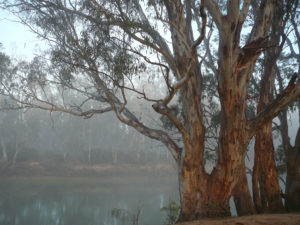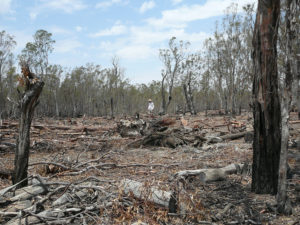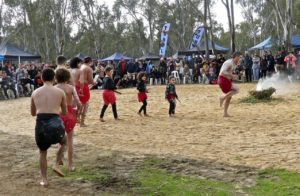Monica Morgan is a Yorta Yorta woman and Chief Executive Officer of Yorta Yorta Nation Aboriginal Corporation (YYNAC). Yorta Yorta country surrounds Dhungala (the Murray River), roughly from Albury-Wodonga in the East to Cohuna in the West, and Kaiela (the Goulburn River) to the south beyond Shepparton.
Monica has been an activist for over fifty years, fighting for the self-determination of her people and to protect Country from threats ranging from logging and poor river management to climate change. She has been a key figure in the establishment of many Aboriginal organisations including the Yorta Yorta Nation Aboriginal Corporation and successful campaigns such as the creation of the Barmah-Millewa National Parks.
For this year’s International Women’s Day, Environment Victoria CEO Jono La Nauze sat down with Monica to discuss the moments in history and the women who have inspired her and taught her. Their conversation spanned many topics – from the Aboriginal Tent Embassy and Black Power movement to Monica’s experiences campaigning for Yorta Yorta land and water rights. The following is an edited transcript.
My reflections start very early, as a young girl growing up along the Murray River – Dunghala – between Echuca-Moama and Cummeragunja. Where I’ve come from is a product of who’s been influencing my life. And of course, that’s very strong black women.
In 1971, my mother, Elizabeth Morgan, made the decision to move to Melbourne with my brothers and myself. We stayed with mum’s sister Merle Jackomos, and we had wonderful elders such as Margaret Briggs, her mother Aunty Geraldine Briggs, Aunty Marge Tucker and Aunty Gladys Nichols and many others – so many very strong women that laid the foundation, really, for much of what’s going on today. I was only a really young girl, but I was heavily influenced.
My mother grew into such a formidable woman, that led the way in advocating for the rights of our people. She became the chairperson and then the director of the Aboriginal Advancement League for over 10 years.
I’ve always been told to be fearless, to be strong and to be very resolute. And that is something that as a Yorta Yorta woman I’ve carried throughout my life.
It’s been the hallmark for how I do business and it’s always in the absolute knowledge that we are the First Peoples. This is our land – stolen – and we’ve never ceded sovereignty to the British invaders.
Every day I go down to the Murray River, Dhungala, and I give thanks to my ancestors. I do that every day and I thank them deeply because if it wasn’t for their will to survive, we wouldn’t be here.

River red gums on the banks of Dhungala. Credit: Jono La Nauze
We went on many marches for land rights as I was growing up, and that’s where I kind of got my mantle fighting for better conditions for our mob. The two defining protests were the Aboriginal Tent Embassy on the lawns of Old Parliament House in 1972 and then after I met my partner, Kevin Whyman, the 1982 Commonwealth Games.
It was after returning from the Commonwealth Games that we went back to Cummeragunja.
Kevin and I said, “We’re not going to fight for land rights around the whole of Australia. We also need to go back to fight and protect our own Country.”
Cummeragunja had a really unique beginning. In 1881 our Elder men signed a petition stating that, as People from the Moira, we wanted land of our own to farm and feed ourselves. It was similar to what the Gurindji done – to acquire land, to be able to farm it and to live on Country next to the Barmah and the Millewa Forests and wetlands, so we could do cultural hunting and gathering. And the land that was delivered to us was Cummeragunja.
Each of the 45 petitioners started to clear blocks and commenced farming wheat and sheep – and to all accounts, we had one of the highest rates of wheat and wool production in the district. We even had a wharf at the back of Cummeragunja where it would be loaded onto the paddle steamers.
But then the Aboriginal Protection Board, made up of white farmers and land owners, kicked up a fuss and took the blocks from our men. The Protection Board stated that all the farmlands would be farmed by the Aboriginal residents for free and they would get rations or would be sent away as farm labourers for the white man. And so this set us back again. Our mob were very, very angry and disillusioned.
I think that was a defining moment – of all that the white man has done to take our country and freedoms and economy away. Coming out of the ashes of that, we had Yorta Yorta leaders like Jack Patten, William Cooper, Marge Tucker, Shadrach James and Aunty Geraldine Briggs – and many other men and women. Many went to Sydney in 1938 during the 150th Bicentenary of British Invasion and held the first Day of Mourning, which is now celebrated each year as National Aboriginal and Islander Day of Commemoration – NAIDOC.
My Yorta Yorta mob have always been very militant and very decisive about taking formalised direct action. And I think that’s the principle that we need to look towards as we strengthen ourselves today, particularly when we reflect on this International Day of Women.
Women are a part of, and always will be, the backbone of our struggle. We will not only be there but can also lead these kind of events.
In 1975, my mum co-established the Yorta Yorta Tribal Council with Margaret Wirrpanda. This organisation would become the precursor to the Yorta Yorta Nation Aboriginal Corporation we have today.
In a petition for our lands to be returned to Yorta Yorta People, we said the Barmah and Moira forests (on both sides of the Murray River) need to be returned to us as the rightful owners. We wanted control and access for our people – to our country, our culture and the resting place of our Ancestors. We wanted the exploitation of our natural resources stopped, such as logging, cattle grazing, sand mining and water extraction.

The impact of logging on Yorta Yorta country
The vision was to build a place where we could look after Country and Culture, a place where all people could learn culture, and where we could exchange our cultures with tribal people throughout the continent. These demands were about giving a stronger place for us, but also having a place that we could share our ideals and aspirations with the wider community.
We’ve now negotiated a joint management agreement with the Victorian government to protect and manage Barmah and to turn it into a national park. It means we have control over what happens on our Country and we have stopped the logging and the cattle grazing – all those destructive things that were happening.
The exploitation of our natural resources is still very strongly up there for Yorta Yorta. Sand mining is still happening on our sacred sand hills in the Moira. Just coming into Cummeragunja you can see the façade of a hill. You go on the other side and it’s all dug out.
I think the importance for the future is to not stop the momentum, to get a foundation that there is self-determination, self-governance and proper land bases and economic bases that aren’t tied to the strings of government. What we’ve found is we don’t need native title. We don’t need any government to say we existed or not. We know that we have and that we’ve survived.
In January I returned to Canberra for the 50th anniversary of the Aboriginal Tent Embassy. I always return there because the Tent Embassy is about real land rights being returned to our mob.
We need the long-term ability to be able to influence what’s going on in our Country. We need to look after our Country. Our rivers are dying and that’s killing our systems, our future generations’ ability to ensure a sustainable future.
The struggle is everyone’s struggle now with climate change. I’m really pleased this year’s theme for International Women’s Day is sustainability and climate change. It’s something our people have always been leaders on. Our old people, even back in the 1880s, were saying something’s wrong – the seasons aren’t right, the animals aren’t right, the watering systems not right.
In my 65 years now, I’ve come a long way in realising that we need all people to work together for the good of our country.
If we are going to be there for our children’s future, we need to start working in a very collaborative way, which recognises First Nations and doesn’t dismiss the need for the intelligence, the input and the vitality that can come with young people’s movements happening today.

Image: Dharnya Day 2021. Credit Tracey O'Keeffe. 'We have invited many of our peoples from all over the world to share in our country and to talk of our rights at the Dharnya Centre. During 2020-21, Yorta Yorta Nation hosted a national climate change conference, national fire stick burning conference, camps ans school groups. It is very important to us for teaching culture and to get us back on Country. It has grounded us, made us aware of what came behind us to push us to where are today'
Header image: Justin McManus, The Age